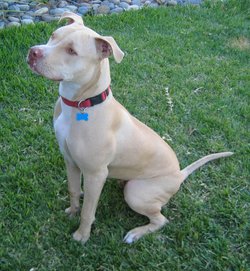American Pit Bull Terrier
|
|
| American Pit Bull Terrier |
|---|
| Alternative names |
| Pit Bull |
| Common nicknames |
| APBT |
| Country of origin |
| United States |
| Classification |
| UKC - Terriers |
| Breed standard (external link) |
| UKC (http://www.ukcdogs.com/breeds/terriers/americanpitbullterrier.std.shtml/) |
| Notes |
| Many AKC registered ASTs can also be registered with the UKC as APBTs. |
The American Pit Bull Terrier (APBT) is a breed of dog in the terrier group, one of several breeds loosely classified as pit bulls. These dogs are known for their strength, loyalty, and ?gameness,? or tenacity.
Due to bad publicity caused by irresponsible owners, people unfamilar with dogs often consider them the most feared type. PBT are often associated with the urban and hip hop culture, and many young (predominantly male) people purchase them on the grounds of wanting a 'tough dog', who usually ends up maltrained and in poor health.
| Contents [hide] |
Appearance
The APBT is the midsized breed of the three generally referred to as pit bulls (see also American Staffordshire Terrier (AST) and Staffordshire Bull Terrier (SBT)). Males should weigh 35 to 65 pounds (16 to 29 kg), females 30 to 60 pounds (16 to 27 kg), with height being proportional. The coat is short, single layered, and stiff but glossy. Any color is accepted. All eye colors are accepted except blue. Ears are rose or semipricked, and may be cropped, although uncropped is preferred. The tail is short and tapering. The body is solidly built and muscular, with a wide chest. The head is wedge shaped with some slight forehead wrinkles.
Confusion among Pit Bull breeds
The three ?pit bull? breeds all have nearly identical standards, with only the acceptable sizes and colors varying. Also, the AST and the APBT have the same heritage. Many people still consider them to be simply different types of the same breed. Dogs registered with the UKC as an APBT are often dual registered with the AKC as an AST. Adding to the muddle is the fact that many people refer to any dog of these breeds, as well as American Bulldogs, as ?pit bulls.?
Temperament and/or characteristics
APBTs can be sweet, loyal, inquisitive, intelligent, and stubborn. They are noted for their outgoing, affectionate, and playful dispostion and their fondness for people, even children. However, a firm, even hand and early obedience training are musts for this breed. APBTs often display some level of dog aggression, especially towards dogs of the same sex or level of assertiveness. With early socialization and knowing each individual dog's limits, their aggression towards other dogs can be quite easily controlled. (Unbridled aggression towards man is actually a serious and perilous fault.) Pit bulls are extremely attached to their owners and families and are known for their eagerness to please their masters. Inexperienced owners tend to find them to be too much to handle-they are a lot of dog with a lot of energy to expend. The National Canine Temperament Testing Association tested 122 breeds, and American Pit Bull Terriers placed the 4th highest with a 95% passing rate.
It is paramount to find a breeder who selects puppies for their good temperment and not for their aggression. Also research the breeder, ask for references and ask to see their facilities and other dogs they have raised. It is also a good policy for owners to have their dog micro-chiped where possible as this breed is often stolen in and near urban areas for ill uses. American Pit Bull Terriers excel in many activites, including weight pulling, search and rescue, agility dog trials, and can even do well in dog obedience. In the United States they have been used as police dogs because of their tenacity, high energy drive, and versatility.
History
Originally bred from English Bulldogs and other breeds brought to America from England and Ireland in the 1700s they were used as working dogs on farms, but also for bullbaiting and dog fighting. When bred for fighting, the breeder would look for strength, gameness, and lack of aggression towards people. Any fighting dog that showed aggression towards its owner or handler would be culled on the spot. This created a line of strong dogs that, while being dog aggressive, would not turn on their owners. In the late 1800s to early 1900s, two clubs were formed for the specific purpose of registering APBTs: the United Kennel Club and the American Dog Breeder's Association. After dog fighting was made illegal in the United States, many dog owners wanted to legitimize the breed and distance it from its fighting roots. The name “Staffordshire Terrier” was adopted by some owners and was recognized by the American Kennel Club in 1936. Later, the word “American” was added to reduce confusion with its smaller cousin, the Staffordshire Bull Terrier. Not all breeders, however, agreed with the standard adopted by the AKC, and continued to use the name APBT for their lines. Much confusion still remains in regards to the APBT, the AST, and the SBT.
Once an extremely popular family dog in the United States, the American Pit Bull Terrier's popularity began to decline in the United States following World War II in favor of other breeds. It has come under fire in the past thirty years for its association with inner city crime and drugs; many people of ill repute mistakenly breed this dog for its fighting heritage and exploit its incredible willingness to please its master (when not refusing to give up its spot on a soft bed.) However, it is of note that this breed is also often the most common target of abuse in urban areas. Outside of dog fighting and guarding a drug dealer's property, the APBT is often beaten, starved, burned, and mistreated to make it particularly aggressive. After the owner no longer has any use for the dog (that is, after it loses a fight), the dog is left for dead or turned loose to find its way into animal control services, where it most likely will need to be destroyed because nobody wants it because of its reputation. (A large percent of dogs destroyed in New York, Chicago, and Los Angeles are pit bull type breeds.)
In jurisdictions where breed-specific legislation threatens ownership of Pit Bulls, owners are often advised by their peers to refer to their Pit Bulls and Pit bull crosses as 'Staffys' or 'Amstaffs', which are generally exempt from such regulations. Purists among American Staffordshire owners find this unethical, and resent it, perhaps fearing that the ultimate result of the subterfuge will be restrictions on their breed as well.
In the United Kingdom, the Dangerous Dogs Act of 1991 prohibits the sale or breeding of "any dog of the type known as pit bull terrier". Some jurisdictions in Queensland Australia and the United States have similar breed-specific legislation.
Famous APBTs
- Stubby, most decorated dog to serve in World War II.
- Pete the Pup, from Hal Roach's Our Gang comedy short films of the 1920s and 30s, later known as The Little Rascals. An APBT was again used for the 1994 Little Rascals film remake as well.
- Dakota and Cheyenne, search and rescue dogs active at the World Trade Center disaster and the explosion of the space shuttle Columbia.
- Popsicle, famous for sniffing out one of the biggest drug busts in FDA history.
- Nipper, the RCA dog (or a breed similar to the APBT).
- Bandog Dread, most titled dog ever with multiple titles in nearly every category.
Dog Pictures and Clipart
- Pictures of Dogs (http://classroomclipart.com/cgi-bin/kids/imageFolio.cgi?direct=Animals/Dogs)
- Dog Clipart (http://classroomclipart.com/cgi-bin/kids/imageFolio.cgi?direct=Clipart/Animals/Dog_Clipart)
Clipart and Animal Pictures
- Clipart (https://classroomclipart.com/image/category/clipart.htm)
- Animal Clipart (https://classroomclipart.com/image/category/animal-clipart.htm)
- Animal Animated Clipart (https://classroomclipart.com/clipart/Animations/Animals.htm)
- Pictures of Animals (https://classroomclipart.com/image/category/animal-photos.htm)
- Amphibian Clip Art, Pictures and Photogaphs (https://classroomclipart.com/image/category/amphibian-clipart.htm)
- Farm Animal Clip Art, Pictures and Photographs (https://classroomclipart.com/image/category/farm-animal-clipart.htm)
- Mammal Clip Art, Pictures and Photographs (https://classroomclipart.com/image/category/mammal-clipart.htm)
- Marine Animal Clip Art, Pictures and Photographs (https://classroomclipart.com/image/category/marine-life-clipart.htm)
- Reptile Clip Art, Pictures and Photographs (https://classroomclipart.com/image/category/reptile-clipart.htm)
- Spider Clip Art, Pictures and Photographs (https://classroomclipart.com/image/category/spider-clipart.htm)



